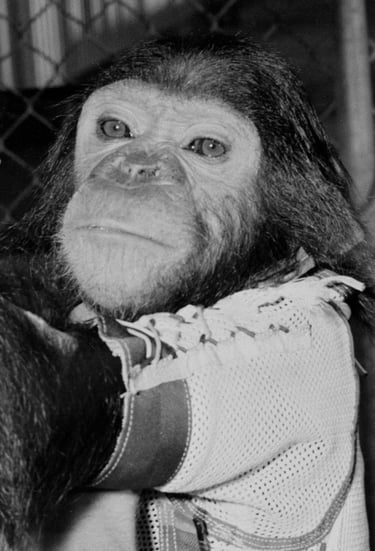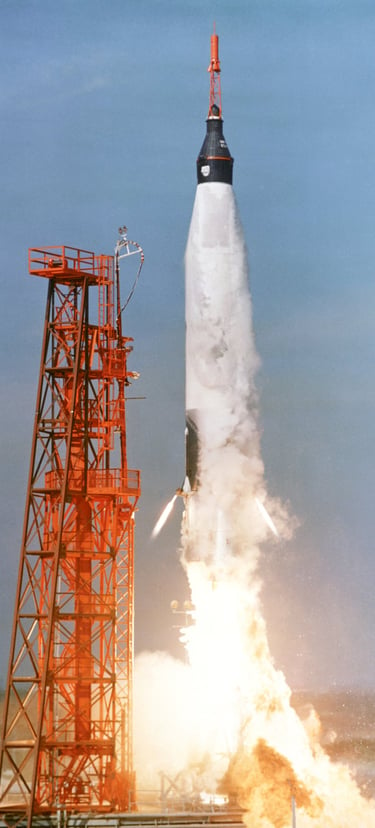

Pioneers shape the path forward, yet so many are forgotten.
They carry the weight of first steps into the unknown, driven not by glory, but by necessity, courage, and something greater than themselves. And among them is one name few remember: Enos.
Not many recall the small chimpanzee was shot of on the top of a rocket into space, Who trained, endured, and became the first and only of his kind to orbit our planet. He didn’t ask to be a pioneer. He simply was. And still, he was shopping the way for humanity in space.
In his quiet bravery, in his unnoticed sacrifice, Enos became more than an astronaut, he became a symbol. A symbol of those who go first, without applause, for the sake of what comes after.
To honor his journey, and the journeys of all pioneers, human or not, and their sacrifices in moving humanity forward, we too will orbit the Earth. Not above it, but around it, by sea.
Our expedition carries Enos’ name as a reminder.
A reminder to remember those who made the impossible possible.
To remember Enos, the space chimpanzee.
To never forget the ones who went first.
The story of Enos?


November 29, 1961 - 10:07 AM. Cape Canaveral, Florida. The countdown echoes across the launchpad.
Three... Two... One...
A thunderous roar rips through the morning sky as Mercury-Atlas 5 blasts off, flames trailing beneath its silver frame. The ground quakes. The air vibrates. Hundreds of scientists, engineers, and dreamers, hold their breath as the rocket shoots off.
We are in the height of the space race. The Soviet Union has already sent humans into orbit. The United States? Still struggling! Their rockets better known for failure than flight. As historian Howard McCurdy would later say, “Nobody could take pride in NASA in 1961. They couldn’t do anything but blow up rockets. Our rocket programs were comical.”
But this flight is no joke. It’s America’s first attempt to orbit the Earth and to test the life-support systems that is planned to carry astronauts into space. And in that tiny capsule, strapped to a narrow metal bench, sits not a man but a chimpanzee named Enos.
Enos, just five and a half years old and weighing 37.5 pounds, was soon to become a space chimp. His name, from the Hebrew word for "man", was a quiet, symbolic nod to the role he was about to play. Trained by the U.S. Air Force, Enos had endured 1,263 hours of rigorous preparation: centrifuge trials, reaction drills, long hours in isolation. He was the second chimp to fly into space, after the playful and beloved Ham, who proved that a living being could survive a suborbital mission without long-lasting problems.
Enos was very different from Ham. He was smart. Serious. Focused - and yes, grumpy. Maybe it was the electric shocks used in training. Maybe it was the cages. Or the unsettling realization that other chimps who left never came back. Honestly, I think I would’ve been grumpy too. Now, he was headed for the ultimate test.
As the rocket climbed, 6.8 Gs of force crushed Enos against his seat, rising to 7.8 Gs after booster separation. Still, he held firm. The first orbit went smoothly, making Enos the first and only chimpanzee to orbit Earth. Then things began to go wrong. A thruster malfunction threw the capsule into an erratic spin, forcing the use of valuable fuel to stabilize the trajectory. Then, the environmental control system began to overheat.
And through it all - Enos worked.
In front of him was a psychomotor panel: lights, levers, and symbols. Pull the right lever, get a reward - fruit juice, water, a banana-flavored pellet. Pull the wrong one? A shock. Then the system failed. Even the correct responses brought pain. Still, Enos persisted. He never stopped. He kept performing his tasks, calmly, mechanically, even as systems failed, even as he was punished for doing everything right. He stayed the course: a silent, steadfast hero gliding high above the Earth.
Mission control made the call to bring him back after two orbits instead of the planned three. At 2:28 PM, after 3 hours and 21 minutes in space, the capsule of Mercury-Atlas 5 splashed down in the Atlantic, south of Bermuda. Enos had made it.
Twenty-five minutes later, he was pulled from the ocean by the USS Storms. Newsletter headlines would later celebrate, titling: “Twist, Enos, Twist!” NASA rejoiced. The mission was a success. The path was clear. Humans would go to orbit next.
Just a year after his historic flight, Enos died of dysentery at Holloman Air Force Base, a quiet end, unrelated to the mission, and one that received no tribute. While Ham was celebrated, placed in a zoo, and lived out his days surrounded by admiration, Enos was quietly forgotten.
Yet we remember. Enos was not just a test subject. He was a pioneer. A small soul sent alone into the void, so that humanity might one day walk on the Moon, explore the planets, and reach for the stars.
We will sail in memory of Enos and the hundreds of animals who gave, and lost, so much in the name of progress. Whatever your view is on animal testing, their sacrifice helped and continues to help advance our journey through space and deepen our understanding of life itself. Thank you, Enos. You will not be forgotten.


If you want to read more:
• Cassidy, David, and Patrick Hughes. One Small Step: America's First Primates in Space. First edition. New York: Chamberlain Brothers, 2005.
• NASA History: Chapter 12
• APA PsycNet - Enos Study
• CiteseerX Enos Paper
Watch Enos here:
• Watch on YouTube
